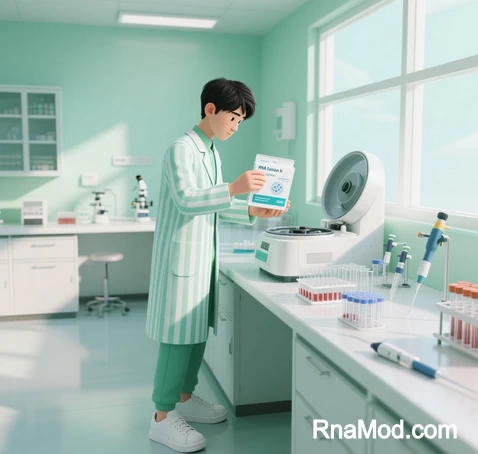 I. Foundational Barriers: Creating RNase-Free Environments
I. Foundational Barriers: Creating RNase-Free Environments
RNA extraction kits establish physical and biochemical barriers to exclude ribonucleases at every workflow stage:
A. Dedicated Workspace Protocols
- Spatial segregation: RNase-free zones with UV-sterilized surfaces and HEPA filtration
- Consumable sterilization:
- DEPC-treated tubes/tips (0.1% diethyl pyrocarbonate for 12h)
- Pre-baked glassware (150°C for 4h)
- Operator protection: Double-gloving with frequent changes; mask usage to prevent salivary RNase contamination
B. Reagent Safeguards
| Component | Protective Function |
|---|---|
| RNase-free water | DEPC-treated or commercially sterilized |
| Ethanol solutions | DEPC-treated 75% ethanol for wash steps |
| Storage buffers | Guanidinium isothiocyanate maintains RNase-denaturing conditions |
(Fig. 1: RNase Containment Workflow)
Description: Cross-section of workstation showing UV sterilization (purple waves), DEPC-treated consumables (blue), and operator PPE (mask/gloves).
II. Chemical Warfare: Direct RNase Inactivation
Kits employ molecular disruptors that dismantle RNase tertiary structure:
A. Chaotropic Agents
- Guanidine salts (4-6M guanidinium isothiocyanate):
- Disrupt hydrogen bonding in RNase active sites
- Denature proteins while keeping RNA soluble
- Phenol-chloroform systems: Create acidic pH (pH 4-5) that destabilizes RNases
B. Reducing Agents
- β-mercaptoethanol (0.1-1.0M): Breaks disulfide bonds critical for RNase function
- DTT alternatives: Thermally stable reductants for automated systems
C. Targeted Inhibitors
- Protease cocktails: Proteinase K digests RNases during lysis
- Vanadyl ribonucleoside complexes: Transition-state analogs that block catalytic activity
(Fig. 2: RNase Denaturation Mechanism)
Description: 3D RNase enzyme (gray) with active site (red) disabled by chaotropic ions (yellow) and disulfide bond cleavage (blue lightning).
III. Physical Containment: Immobilization & Exclusion
A. Matrix-Based Capture
- Silica membranes:
- Selective RNA binding at high chaotrope concentrations
- Physical barrier separating RNA from soluble RNases
- Magnetic beads:
- Oligo-dT functionalization for mRNA isolation
- Silica coating creates RNase-impermeable surface
B. Phase Separation
- TRIzol-based systems:
- Phenol-induced partitioning confines RNases to organic phase
- Interphase “lock” traps denatured proteins
- Density gradients: Sucrose cushions protect RNA during centrifugation
(Fig. 3: Physical Protection Systems)
Description: Left: Silica membrane blocking RNases (red) while binding RNA (blue). Right: Phase separation showing RNases trapped in phenol layer (bottom).
IV. Sample-Specific Defense Protocols
A. FFPE Samples
| Challenge | Solution |
|---|---|
| Formaldehyde crosslinks | Xylene deparaffinization → rehydration cascade |
| Protein-RNA adducts | Proteinase K digestion (24h at 56°C) |
| Fragmented RNA | Carrier RNA (MS2 bacteriophage) added pre-extraction |
B. Whole Blood/Plasma
- Leukocyte stabilization: Tempus™ tubes with RNA-stabilizing reagents
- Hemoglobin inhibition: Chelating agents neutralize metal-dependent RNases
C. Microbiome-Rich Samples
- Dual treatments: DNase I + RNase inhibitor cocktails
- Polysaccharide shields: PVP-40 prevents polyphenol oxidation
V. Post-Isolation Protection
A. Stabilization Chemistry
- RNAlater™ solutions: Quaternary ammonium salts create protective micelles
- Cryopreservation: Immediate flash-freezing in liquid N₂
B. Storage Formats
| Condition | Stability | Use Case |
|---|---|---|
| -70°C ethanol suspension | >2 years | Long-term biobanking |
| Lyophilized RNA | Indefinite | Field research |
| Stabilization matrices | 7 days room temp | Clinical transport |
VI. Quality Control Paradigms
A. Degradation Detection
- Bioanalyzer profiling: RIN >7.0 indicates intact 18S/28S rRNA
- 3′:5′ ratio assays: Nanodrop assessment of degradation bias
B. Contamination Checks
- gDNA testing: RT-PCR with no-RT controls
- Protein residuals: A260/A280 >1.9 confirms RNase-free state
(Fig. 4: QC Verification Workflow)
Description: Bioanalyzer electropherogram (top) showing intact rRNA peaks. Bottom: Nanodrop purity ratios with pass/fail indicators.
“Modern RNA extraction kits deploy triple-shield technology—spatial barriers, molecular disruptors, and phase containment—to preserve RNA’s fragile message against nature’s most efficient destroyers.”
— Nature Methods, 2025
Data sourced from publicly available references. For collaboration inquiries, contact: chuanchuan810@gmail.com.
